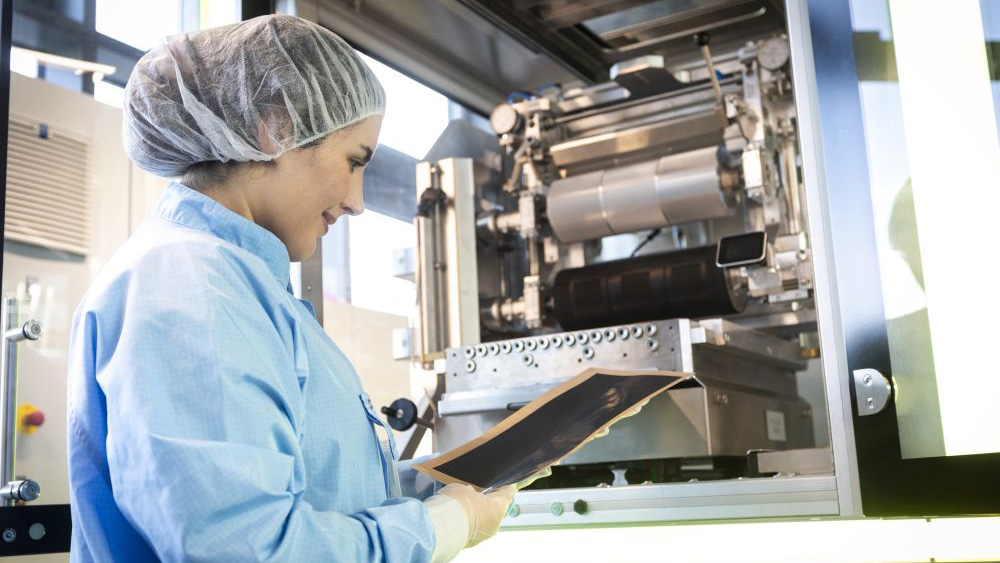News #8
Large-scale production of PEM electrolyzers: Catalyst inks for scalable printing technologies with reduced iridium loading
Electrolyzers make it possible to greatly expand the use of renewable energies by producing hydrogen, which can be used to store clean energy. In order to facilitate the high-volume production of competitive stacks for PEM electrolysis in the near future, researchers at the Fraunhofer Institute for Solar Energy Systems ISE are investigating scalable processes such as slot-die coating and screen printing for the production of catalyst layers for the membrane electrode assembly (MEA). They have now developed catalyst inks for both production processes that enable the production of catalyst layers with lower iridium loading and high throughput. This significantly reduces the material and manufacturing costs for PEM electrolyzers.

In addition to other innovations for the hydrogen economy, Fraunhofer ISE will be presenting MEAs manufactured using the screen printing or slot-die process at the Hannover Messe from April 22 to 26, 2024 in Hall 13, Stand C41.
Among the various electrolysis technologies, proton exchange membrane (PEM) electrolysis is of particular interest, as it can be operated at higher current densities than alkaline water electrolysis or solid oxide electrolysis. Moreover, PEM electrolysis is ideally suited for the dynamic balancing of electricity grids due to its high flexibility, i.e. its short start-up time and wide load range. However, more research is still required to increase efficiency and reduce production costs in order to scale up this technology in the near future.
The MEA, consisting of the proton exchange membrane and two catalyst layers, is the central component of an electrolysis cell and contributes to a majority of the stack costs. “The anode electrode, which contains the rare and expensive precious metal iridium as a catalyst material, is a particular cost driver,” explains Tom Smolinka, Head of the Electrolysis and Hydrogen Infrastructure department. “In order to ramp up the hydrogen economy, production research into MEAs will have to focus on industrial and innovative manufacturing processes while conserving resources with regard to the use of materials,” Smolinka continues.
The iridium loading of a catalyst layer is directly related to the performance values of an MEA. “We have now been able to show that catalyst layers with loadings of 0.3 mg iridium per square centimeter achieve comparable performance values for both coating technologies,” explains Jerónimo Horstmann de la Vina, researcher in the Production Laboratory for Fuel Cell and Electrolysis Research. “This value meets the strict requirements of the US Department of Energy.”
The researchers are now also able to use the screen printing process on an area of approx. 400 cm2. “This also helps to reduce manufacturing costs,” explains Horstmann de la Vina, “as it enables more rapid production.” Increasing the printable area and reducing the iridium load is the subject of further research. The know-how generated in this way should help German companies from the plant construction, materials production and energy sectors to take the lead in the internationally competitive MEA production market.
Researchers at Fraunhofer ISE have been involved in various national and international projects since 2019 to develop large-scale production of membrane electrode units for use in both electrolyzers and fuel cells, with a focus on reducing catalyst materials and on quality assurance methods.
Further Innovations at the Hannover Messe
The Fraunhofer ISE stand in Hall 13 at the Hannover Messe will also be presenting further innovations:
The AEM laboratory electrolysis test cell for the in-situ characterization of new materials is a further development of the proven PEM electrolysis test cell design and is used for the precise characterization and qualification of various components, such as membranes, porous transport layers and catalysts.
The 3D exhibit “Hydrogen Infrastructure” presents a model region consisting of a local H2 ecosystem with a connection to a transregional H2 pipeline and regional H2 production, distribution and storage.
The Power-to-X (PtX) concept is based on the conversion of renewable energy into liquid fuels and chemicals such as methanol, ammonia, dimethyl ether (DME) or oxymethylene ether (OME). Fraunhofer ISE’s PtX Cube at the Hannover Messe presents these different hydrogen-based energy carriers in terms of their relative energy density compared to non-pressurized and compressed hydrogen.
Researchers from Fraunhofer ISE will also provide insights into their work during public presentations and guided tours of the stand.
Presentation “Hydrogen in series: electrolysis | reforming | reliability | fuel cells”
Prof. Dr. Christopher Hebling, Dr. Tom Smolinka, Fraunhofer ISE
April 23, 11:00–12:00, Technical Forum, Hall 13, Stand A30; language: English
Guided tours, in English, of the Fraunhofer ISE stand: April 22 to April 26, 10:00 to 10:30 a.m. daily, with different topics each day
Monday
Characterization of materials and components – AEM electrolysis cell developed at Fraunhofer ISE
What impact do new types of materials, operating modes and external influences have on electrolyzers?
Tuesday
Series production of fuel cell membranes – a variety of in-house manufactured MEAs for mobile PEM fuel cells
How can the production of membrane electrode assemblies for fuel cells and electrolyzers be transferred to series production?
Wednesday
H2 Infrastructure – Regional production, distribution & storage
Where, when and how can hydrogen and its derivatives be produced, used, stored and transported in order to reach the right application at the right time and under the right economic conditions?
Thursday
Hydrogen-based energy carriers – Fraunhofer ISE’s PtX Cube
Which hydrogen-based storage medium is the most efficient? How can synthesis, transportation and reforming be made particularly sustainable?
Friday
Scaling up the production of electrolyzer membranes – value chain of MEAs for electrolyzers
What influence do process design, materials and component design have on costs, quality and performance?
Last modified: